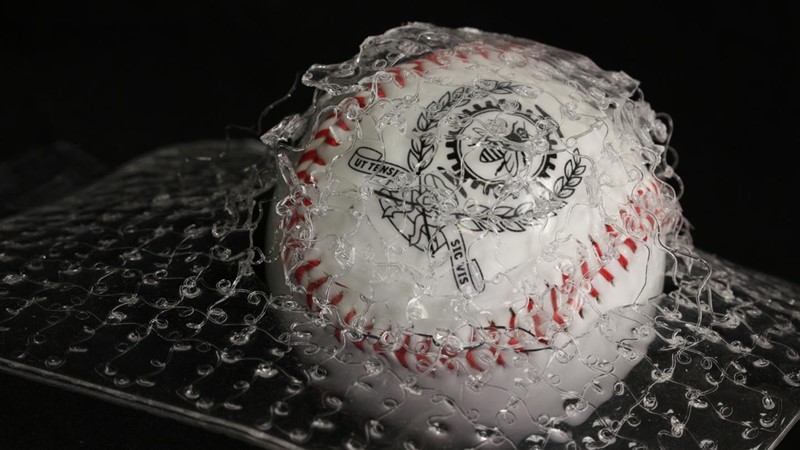A team of Candian researchers from the Department of Mechanical Engineering at Polytechnique Montréal has used 3D printing to design a fabric that can absorb up to 96% of an impact without breaking.
The team took inspiration from the natural properties of spiderwebs to create durable 3D printed coverings for phones and other fragile technology devices by heating Polycarbonate (PC) to make an adhesive. PC filament was chosen because of its low viscosity when extruded by a Fused Filament Fabrication (FFF) 3D printer.
In the future, the 3D printed material could be used to create bullet-proof glass or even applied in aeronautics as a protective coating for aircraft engines.
Manufacturing 3D printed shatterproof material
The researchers heated PC to create the material as when the polymer is heated it molds into a sticky adhesive similar to honey, which can be used to replicate properties found in spiderwebs. The team wanted to recreate these properties for their impact-absorbing capabilities, demonstrated when resisting the impact of prey.
To do this, the researchers used an instability-assisted fused filament fabrication (IFFF) 3D printer to create the transparent and impact-absorbing 3D printed material. In the IFFF process, PC is partially melted and then extruded at speed onto the printing platform.
Professor Frédérick Gosselin’s team heated the PC and ‘weaved’ a series of fibers less than 2mm thick. The process was repeated and several fibres were 3D printed at a 90° angle until the entire ‘web’ was solidified. During the process, the molten plastic creates circles to form a sequence of loops. According to Professor Gosselin, the loops will turn into sacrificial links, which are removable bonds after printing, to give the fiber additional strength.
She added: “When impact occurs, those sacrificial links absorb energy and break to maintain the fibre’s overall integrity — similar to silk proteins.”

Testing the strength of the shatterproof material
The study aims to develop a mechanism on a microscopic scale to create a new impact-absorbing fibre that could release large amounts of energy without breaking.
To this end, the report investigated how the material’s fibers behaved when intertwined. Impact tests were carried out to see if embedding the 3D printed material into a glass pane would prevent it from shattering. The results showed that instead of shattering, the material would deform in certain places but the overall shape of the plastic wafers would remain intact.
The faux spiderweb was put to the test further when the team wanted to see if it could catch a free-falling baseball. The 500g baseball was dropped from a 66cm height on to a falling dart impact tester.
The test highlighted the impact of the baseball as it made contact with the material. Under impact, the kinetic energy of the baseball was largely dissipated by the sacrificial bonds breaking and their hidden lengths unfolding. The results displayed the same energy-dissipating mechanism found in spiderwebs.
Further details of this study can be found in the article titled “Spiderweb-Inspired, Transparent, Impact-Absorbing Composite,” published in the Cell Reports Physical Science journal. It is co-authored by Professors Frédérick Gosselin, Daniel Therriault and doctoral student Shibo Zou.

Polycarbonate and 3D printing
In recent years, many companies have used PC filaments for a wide range of projects. Earlier this year, 3D printing material provider Polymaker qualified three PC materials for its Stratasys subsidiary MakerBot LABS and made them available to print on its METHOD X3D printer. The new addition reduces warping and curling and the PC’s will give METHOD X users access to the strong mechanical and thermal properties of PC as well as taking the METHOD’s portfolio up to a total of nine materials.
Previously, Polymaker also worked with German high-performance polymer manufacturer Covestro to launch three new PC based materials specifically for 3D printing. The thermoplastic polymers are designed to contain specific properties that can be applied to industries such as aerospace and electronics.
Additionally, last week Covestro used Formnext Connect’s virtual stage to introduce a new and more sustainable line of 3D printing materials. The new line of filaments will address the circular economy concept with its Addigy range, which is partially built of recycled plastics. The eco-friendly polymers can amplify the potential environmental benefits of 3D printing such as demand-driven production and reduced material waste.
Check us out on Twitter and Facebook for more updates! Don’t forget to subscribe to the 3D Printing Industry newsletter to keep up-to-date with the latest 3D printing news.
Are you looking for a job in the additive manufacturing industry? Visit 3D Printing Jobs for a selection of roles in the additive manufacturing industry.
Feature image shows 500g baseball covered in the 3D printed material after an impact test. Photo via Polytechnique Montréal.


